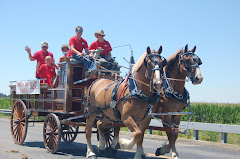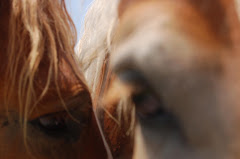Percherons

 The Percheron horse originated from France in the province of Le Perche, located about 50 miles southwest of Paris. Traditionally, the Percheron breed was a breed of greys. Used as a war horse, the French Knight is almost always seen on a grey or white horse. When the day of the war horse was over, Percherons were used to pull heavy stage coaches in France. These horses could trot 7-10 miles per hour with the endurance to perform day in and day out. The light colored greys and whites were easily seen at night and thus preferred. When the railroad replaced the stage coaches and horses began to replace oxen in agriculture, the need for a heavier draft horse grew. The breeders of Le Perche complied. From war horse to light draft coach to heavy draft, the Percheron breed was developed.
The Percheron horse originated from France in the province of Le Perche, located about 50 miles southwest of Paris. Traditionally, the Percheron breed was a breed of greys. Used as a war horse, the French Knight is almost always seen on a grey or white horse. When the day of the war horse was over, Percherons were used to pull heavy stage coaches in France. These horses could trot 7-10 miles per hour with the endurance to perform day in and day out. The light colored greys and whites were easily seen at night and thus preferred. When the railroad replaced the stage coaches and horses began to replace oxen in agriculture, the need for a heavier draft horse grew. The breeders of Le Perche complied. From war horse to light draft coach to heavy draft, the Percheron breed was developed. 
This picture belows show two teams in exhibition. Note the one team is a team of black Percherons and the other team is a team of greys.

Percheron gelding being driven in the Ladies cart class.
 Just as other European draft horses, the Percheron breed was heavily imported into the US in the 1870s and 80s. The current Percheron Horse Association of America was formed in 1905. The number of registrations grew until the 1940s and WWII. The low point in Percheron registrations came in 1954 when just 85 head were recorded. Just like the Belgian breed, a handful of breeders persisted and Americans rediscoverd the usefulness of the draft horse. Since then, the Percheron breed has seen a resurgence in its numbers and value.
Just as other European draft horses, the Percheron breed was heavily imported into the US in the 1870s and 80s. The current Percheron Horse Association of America was formed in 1905. The number of registrations grew until the 1940s and WWII. The low point in Percheron registrations came in 1954 when just 85 head were recorded. Just like the Belgian breed, a handful of breeders persisted and Americans rediscoverd the usefulness of the draft horse. Since then, the Percheron breed has seen a resurgence in its numbers and value.While greys and dapples are still commonly seen, the Percheron breed is noted for its coal black color. The picture below is a grey Percheron mare.

Clydesdale
 The Clydesdale breed originated from Scotland in the district of Lanarkshire. As with the other European draft breeds, these horses were originally developed for use in warfare to carry knights into battle. A heavier breed was needed to carry armor-clad warriors to war. When the need for war horses declined, the Clydesdale horse was bred not only for agriculture but for heavy haulage in the coalfields of Lanarkshire. The Clydesdale breed flourished in the late 19th century leading to large numbers of exports into Australia, New Zealand, Canada and the United States. Today, the Clydesdale is virtually the only draft breed in its native Scotland.
The Clydesdale breed originated from Scotland in the district of Lanarkshire. As with the other European draft breeds, these horses were originally developed for use in warfare to carry knights into battle. A heavier breed was needed to carry armor-clad warriors to war. When the need for war horses declined, the Clydesdale horse was bred not only for agriculture but for heavy haulage in the coalfields of Lanarkshire. The Clydesdale breed flourished in the late 19th century leading to large numbers of exports into Australia, New Zealand, Canada and the United States. Today, the Clydesdale is virtually the only draft breed in its native Scotland.  The picture above is "Samurai" owned by Dr. Linda-first place gelding and 1st place American Bred Gelding at the National Clydesdale show.
The picture above is "Samurai" owned by Dr. Linda-first place gelding and 1st place American Bred Gelding at the National Clydesdale show.  A clydesdale halter class.
A clydesdale halter class. The modern Clydesdale stands between 16 and 19 hands, weighing in from 1600 to 2200 pounds. The Clydesdale has a very distinctive look with its most common color being bay. A large amount of white on the face and four white stockings with the long white "feathered" legs create a vivid picture. The feather is the long silky hair on the legs that flow to the ground. Other colors in the Clydesdale breed include black and roan. The Clydesdale Breeders of the United States incorporated in 1879 to register and preserve the pedigree of the Clydesdale Breed. 

So, now you know about the characteristics of the three major draft breeds: Belgians, Percherons and Clydesdales. If you are interested in seeing more of the draft breeds or perhaps even owning a draft horse, I encourage you to seek out breeders and exhibitors in your area.
More information can also be found on each of these breed registeries websites:












Loving the articles on the draft horses and looking forward to reading more stuff in the near future about things you have to post about. Curious if you know anything about American Cream Drafts? One of my horse loves though I have never owned one myself.
ReplyDelete